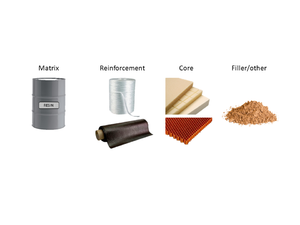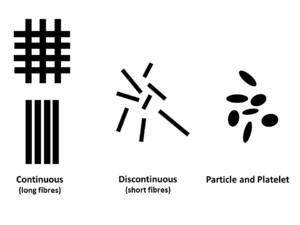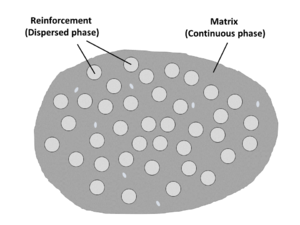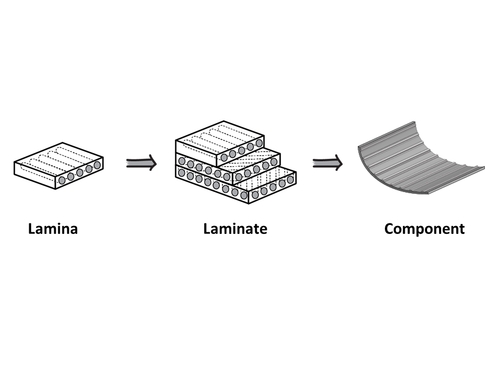Material structure - A152
| Material structure | |
|---|---|
| Foundational knowledge article | |

| |
| Document Type | Article |
| Document Identifier | 152 |
| Themes | |
| Tags | |
Overview[edit | edit source]
Solid materials are categorized into basic group classifications defined by their chemical makeup and atomic structure [1]. They fall into three basic classifications: metals, ceramics, and polymers. Composite materials are by definition a mix of two or more distinct material classes.
The two main material constituents, or parts, that comprise a composite material are the matrix and the reinforcement. Additional materials such as a core and matrix filler materials may also be integrated into the composite material.
Polymer (Matrix) Structure[edit | edit source]
Link to main Polymer (matrix) structure page
For composite materials, the function of the matrix component is to hold in place the load bearing reinforcement fibres, and assist in the load transfer between them. Other functions of the matrix include: supporting the reinforcement in compression (in the case of fibres), and protecting the reinforcement from the environment with moisture and chemical resistance. Polymers are a popular choice for matrix material in combination with glass or carbon reinforcement fibres.
Popular polymer matrix materials include:
- Epoxy (thermoset)
- Polyester (thermoset)
- Polypropylene (thermoplastic)
- Polyethylene (thermoplastic)
On the polymer (matrix) structure page, you will find a general overview about polymer materials, and links to learn more about thermoset and thermoplastic polymers.
To learn about resin matrix materials:
Reinforcement Structure[edit | edit source]
Link to main Reinforcement Structure page
The choice of the reinforcement form (size and shape) is important, with each having different mechanical behaviour on its own and influence in the composite material. The choice of reinforcement form is generally dependent upon the application. In addition, each reinforcement form also has its own composite manufacturing considerations.
The common reinforcement material forms are:
- Continuous fibre reinforcement
- Discontinuous fibre reinforcement
- Particle and platelet reinforcement
See the catalogue volume reinforcement page here, for commercially available reinforcement materials and their suppliers.
To learn about fibre reinforcement materials:
Composite Structure[edit | edit source]
Link to main Composite structure page
Uniting all the individual material constituents together forms the composite material. It is comprised of the two main components:
- Reinforcement material (the load bearing material)
- Matrix material (the binding / hold everything together material)
Other materials that may make up and add function to the composite include:
- Core materials (for sandwich panel structures)
- Matrix fillers and tougheners
- Interphase materials such as fibre sizing
- Other auxiliary materials such as fixation inserts, copper mesh, etc.
Laminate structure[edit | edit source]
Composite materials are typically constructed by laminating, or stacking layers of material (lamina) on top of each other. The individual layers are then arranged at various angles to provide stiffness and strength in desired directions. The term “laminate” is often used to refer to a composite material, particularly for fibre reinforced polymers (FRPs), originates from this lamination structure approach that is typically used to construct composite materials.
The ability to tailor each layer of the material while building up the component or structure – gives composite materials great flexibility for optimizing the reinforcement orientation for specific load paths in the constructed component.
To learn about the mechanics of laminated composites:
- Click here to view the KPC AIM Event: Composite materials engineering webinar session 8 - Mechanics of composites - Part 1: Lamina level
- Click here to view the KPC AIM Event: Composite materials engineering webinar session 9 - Mechanics of composites - Part 2: Laminate level
Explore this area further
References
| About | Help |
Welcome
Welcome to the CKN Knowledge in Practice Centre (KPC). The KPC is a resource for learning and applying scientific knowledge to the practice of composites manufacturing. As you navigate around the KPC, refer back to the information on this right-hand pane as a resource for understanding the intricacies of composites processing and why the KPC is laid out in the way that it is. The following video explains the KPC approach:
Understanding Composites Processing
The Knowledge in Practice Centre (KPC) is centered around a structured method of thinking about composite material manufacturing. From the top down, the heirarchy consists of:
- The factory
- Factory cells and/or the factory layout
- Process steps (embodied in the factory process flow) consisting of:
The way that the material, shape, tooling & consumables and equipment (abbreviated as MSTE) interact with each other during a process step is critical to the outcome of the manufacturing step, and ultimately critical to the quality of the finished part. The interactions between MSTE during a process step can be numerous and complex, but the Knowledge in Practice Centre aims to make you aware of these interactions, understand how one parameter affects another, and understand how to analyze the problem using a systems based approach. Using this approach, the factory can then be developed with a complete understanding and control of all interactions.
Interrelationship of Function, Shape, Material & Process
Design for manufacturing is critical to ensuring the producibility of a part. Trouble arises when it is considered too late or not at all in the design process. Conversely, process design (controlling the interactions between shape, material, tooling & consumables and equipment to achieve a desired outcome) must always consider the shape and material of the part. Ashby has developed and popularized the approach linking design (function) to the choice of material and shape, which influence the process selected and vice versa, as shown below:
Within the Knowledge in Practice Centre the same methodology is applied but the process is more fully defined by also explicitly calling out the equipment and tooling & consumables. Note that in common usage, a process which consists of many steps can be arbitrarily defined by just one step, e.g. "spray-up". Though convenient, this can be misleading.
Workflows
The KPC's Practice and Case Study volumes consist of three types of workflows:
- Development - Analyzing the interactions between MSTE in the process steps to make decisions on processing parameters and understanding how the process steps and factory cells fit within the factory.
- Troubleshooting - Guiding you to possible causes of processing issues affecting either cost, rate or quality and directing you to the most appropriate development workflow to improve the process
- Optimization - An expansion on the development workflows where a larger number of options are considered to achieve the best mixture of cost, rate & quality for your application.
To use this website, you must agree to our Terms and Conditions and Privacy Policy.
By clicking "I Accept" below, you confirm that you have read, understood, and accepted our Terms and Conditions and Privacy Policy.









